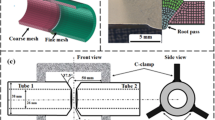Abstract
Manufacturing engineers are facing new challenges during machining of electrically nonconducting or partially conducting materials such as glass, quartz, ceramics, and composites. Traveling wire electrochemical spark machining (TW-ECSM), a largely unknown technology, has been applied successfully for cutting these types of materials. However, hardly any theoretical work has been reported related to machining performance of TW-ECSM process. The present work is an attempt in this direction. In the present work, a 3-D finite element transient thermal model has been developed to estimate the temperature field and material removal rate (MRR) due to Gaussian distributed input heat flux of a spark during TW-ECSM. First, the developed code calculates the temperature field in the workpiece and then MRR is calculated using this temperature field. The calculated MRR has been compared with the experimental MRR for verifying the approach. Computational experiments have been performed for the determination of energy partition and spark radius of a single spark. The effects of various process parameters such as energy partition, duty factor, spark radius, and ejection efficiency on MRR have been reported. It has been found that MRR increases with increase in energy partition, duty factor, and ejection efficiency but decreases with increase in spark radius.
Similar content being viewed by others
References
McGeough JA, El Hofy H (1988) Evaluation of an apparatus for electrochemical arc wire-machining. J Eng Ind 110:119–123
Kurafuji H, Suda K (1968) Electrical discharge drilling of glass. Ann CIRP 16:415–419
Wuthrich R, Fascio V (2005) Machining of non-conducting materials using electrochemical discharge phenomenon-an overview. Int J Mach Tools Manuf 45:1095–1108. doi:10.1016/j.ijmachtools.2004.11.011
Basak I, Ghosh A (1996) Mechanism of spark generation during electrochemical discharge machining: a theoretical model and experimental investigation. J Mater Process Technol 62:46–53. doi:10.1016/0924-0136(95)02202-3
Jain VK, Dixit PM, Pandey PM (1999) On the analysis of the electro chemical spark machining process. Int J Mach Tools Manuf 39:165–186. doi:10.1016/S0890-6955(98)00010-8
Kulkarni A, Sharan R, Lal GK (2002) An experimental study of discharge mechanism in electrochemical discharge machining. Int J Mach Tools Manuf 42:1121–1127. doi:10.1016/S0890-6955(02)00058-5
Wuthrich R, Bleuler H (2004) A model for electrode effects using percolation theory. Electrochim Acta 49:1547–1554
Yerokhin AI, Nie X, Leyland A, Maetthews A, Dowey SJ (1999) Plasma electrolysis for surface engineering. Surf Coat Tech 122:73–93. doi:10.1016/S0257-8972(99)00441-7
Vogt H (1999) The anode effect as a fluid dynamic problem. J Appl Electrochem 29:137–145. doi:10.1023/A:1003477004486
Fascio V, Wuthrich R, Bleuler H (2004) Spark assisted chemical engraving in the light of electrochemistry. Electrochim Acta 49:3997–4003. doi:10.1016/j.electacta.2003.12.062
Wuthrich R, Hof LA, Lal A, Fujisaki K, Bleuler H, Mandin P, Picard G (2005) Physical principles and miniaturization of spark assisted chemical engraving (SACE). J Micromech Microeng 15:268–275. doi:10.1088/0960-1317/15/10/S03
Jain VK, Rao PS, Choudhury SK, Rajurkar KP (1991) Experimental investigations into traveling wire electrochemical spark machining (TW-ECSM) of composites. J Eng Ind 113:75–84
Singh YP, Jain VK, Kumar P, Agrawal DC (1996) Machining piezoelectric (PZT) ceramics using an electrochemical spark machining (ECSM) process. J Mater Process Technol 58:24–31. doi:10.1016/0924-0136(95)02102-7
Peng WY, Liao YS (2004) Study of electrochemical discharge machining technology for slicing non-conductive brittle materials. J Mater Process Technol 149:363–369. doi:10.1016/j.jmatprotec.2003.11.054
Nesarikar VV, Jain VK, Choudhury SK (1994) Traveling wire electrochemical spark machining of thick sheets of Kevlar–epoxy composites. Proceedings of the Sixteenth AIMTDR Conference, pp 672–677
Basak I, Ghosh A (1997) Mechanism of material removal in electrochemical discharge machining: a theoretical model and experimental verification. J Mater Process Technol 71:350–359. doi:10.1016/S0924-0136(97)00097-6
Bhondwe KL, Yadava V, Kathiresan G (2006) Finite element prediction of material removal rate due to electrochemical spark machining. Int J Mach Tools Manuf 46:1699–1706. doi:10.1016/j.ijmachtools.2005.12.005
Prasad BVSSS, Mishra PK, Banerjee S (1997) Analysis of three-dimensional transient heat conduction for predicting wire erosion in the wire electrical discharge machining process. J Mater Process Technol 65:134–142. doi:10.1016/0924-0136(95)02253-8
Hargrove SK, Ding D (2007) Determining cutting parameters in wire EDM based on workpiece surface temperature distribution. Int J Adv Manuf Technol 34:295–299. doi:10.1007/s00170-006-0609-0
Venkatashan SP (2004) First course in heat transfer. Ane Books, New Delhi
Reddy JN (2005) An introduction to finite element method, 3rd edn. McGraw-Hill, New Delhi
Nayar A (2002) The steel hand book. McGraw-Hill, New Delhi
Author information
Authors and Affiliations
Corresponding author
Rights and permissions
About this article
Cite this article
Panda, M.C., Yadava, V. Finite element prediction of material removal rate due to traveling wire electrochemical spark machining. Int J Adv Manuf Technol 45, 506–520 (2009). https://doi.org/10.1007/s00170-009-1992-0
Received:
Accepted:
Published:
Issue Date:
DOI: https://doi.org/10.1007/s00170-009-1992-0




